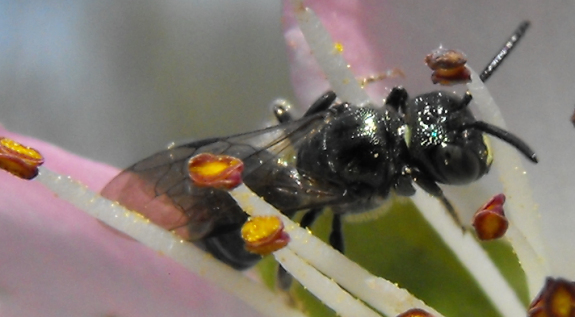
Small carpenter bees: Ceratina sp.

Over half of the
pollinators visiting our peach tree were miniscule and
flighty, hard to catch a glimpse of let alone capture on film. I
did manage to snag a photo of this Small Carpenter Bee (Ceratina sp.),
which might be better named Teeny-tiny Carpenter Bee. Small
Carpenter Bees are sometimes confused with sweat bees, but the carpenter bees
have a club-shaped abdomen, a dull metallic color (versus the brilliant
color of some sweat bees), inconspicuous hair, and a pale yellow patch
on the face.
Small Carpenter Bees (Ceratina sp.)
are related to the larger carpenter bees that drill holes in your porch
and weaken the integrity of the wood, but their life cycle is a bit
different. Ceratina bees are much more likely to
be found in wild areas,
where they nest in the pith of broken plant stems. We have all
five of their favorite nesting species on our farm --- elderberry, box
elder, sumac, blackberry, and sunflower --- and I have a sneaking
suspicion the bees might also use the large, woody stems of wingstem
which are so prevalent in our floodplain.
Small Carpenter Bees
make good pollinators because they can be quite
numerous and aren't picky about the flowers they visit. To
encourage them in your yard, leave some brushy, wild areas around for
the bees to nest in, or plant sunflowers and leave the stems standing
all winter. You may be rewarded with a horde of tiny bees
visiting your flowers in the spring.
| This post is part of our Native Pollinators lunchtime series.
Read all of the entries: |
Want more in-depth information? Browse through our books.
Or explore more posts by date or by subject.
About us: Anna Hess and Mark Hamilton spent over a decade living self-sufficiently in the mountains of Virginia before moving north to start over from scratch in the foothills of Ohio. They've experimented with permaculture, no-till gardening, trailersteading, home-based microbusinesses and much more, writing about their adventures in both blogs and books.
Want to be notified when new comments are posted on this page? Click on the RSS button after you add a comment to subscribe to the comment feed, or simply check the box beside "email replies to me" while writing your comment.

I'm glad you mentioned these!
I was just observing a few today and noticing for the first time the many holes in one of my plantless berms from last fall from which they recently emerged.
Great post thank you thought you might enjoy my machinima film on permaculture and the bees http://www.youtube.com/watch?v=CsVL22dIdKw bright blessings elf ~